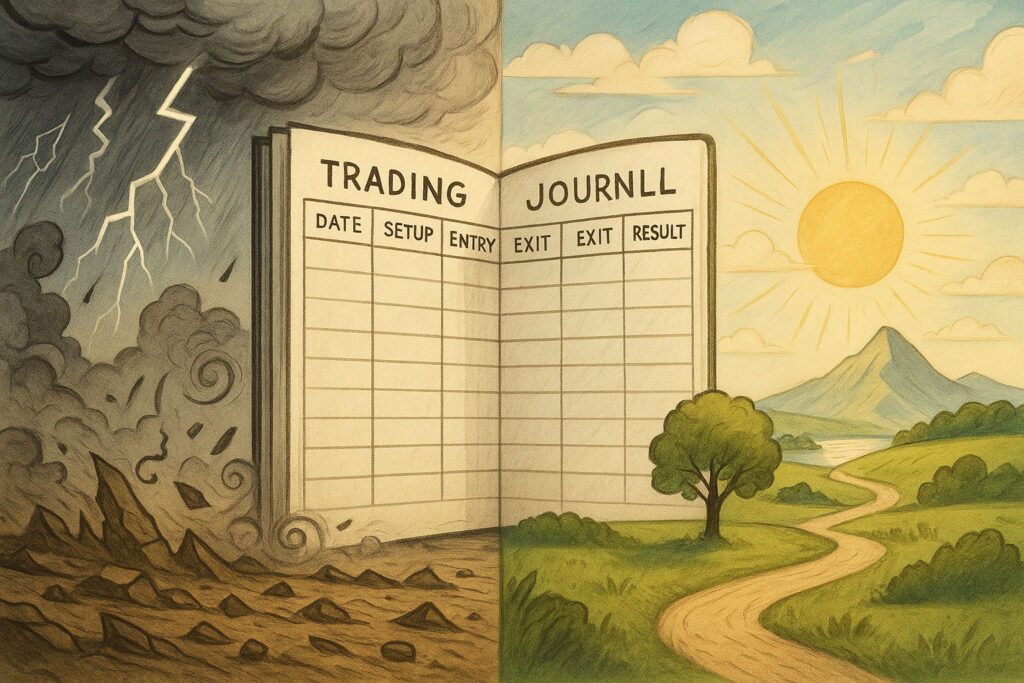Beginner’s Guide to Keeping a Crypto Trading Journal

Written by a trading-psychology specialist with 5+ years analysing trader behaviour, decision fatigue and emotional pattern recognition.
A crypto trading journal is the most underrated performance tool in a trader’s arsenal. Everyone obsesses over indicators, strategies, and entry scripts, but very few track the only variable that matters – their own behaviour. After a decade of coaching traders, I can say with confidence: the ones who record their trades honestly are the ones who last.
🎥 Watch our short video below about why beginner’s should keep a Crypto Trading Journal.
This guide teaches beginners how to build a trading journal that actually improves performance, reduces emotional errors, and helps you make consistently rational decisions in an irrational market. Whether you trade Bitcoin, altcoins, memecoins, or leverage products, the principles here apply universally.
We will cover:
- Why a crypto trading journal solves the biggest problems new traders face
- Exactly what to record (templates + examples)
- How to track emotional states and bias patterns
- How journaling helps with managing stress in volatile markets
- How journaling breaks patterns of cutting out revenge trading
- The journaling habits used by pros with a mindset of a long term trader
- How journaling protects you from social media influence and hype
- How to identify and reduce emotional noise and FUD reduction
- A full trading-journal template you can add to your notes or add to your Crypto Mental Log journal
Why Beginners Struggle Without a Crypto Trading Journal

Most beginners fail not because of poor strategy, but because they have zero visibility into their decision-making patterns. Ask a struggling trader why they lost money last month and you’ll often get a vague answer like:
- “Bad market conditions.”
- “BTC dumped out of nowhere.”
- “I panicked sold but only because the chart looked bad.”
These answers reveal the core problem – a lack of self-awareness.
A trading journal forces clarity. It exposes:
- Which setups truly work
- Which ones only work in hindsight
- Your emotional triggers
- Your overconfidence patterns after a win streak
- Your hesitations and fear after losses
- Your reliance on Twitter, YouTube, Discord or Telegram for conviction
- Your tendency to chase moves too late
And most importantly: a journal shows how your mental state correlates with your results.
Crypto is particularly brutal because volatility amplifies emotions. A newcomer who’s never seen a traditional equity move more than 2 percent in a day is suddenly exposed to 12 percent hourly candles, liquidation cascades, and “market-wide fear” that spreads like wildfire.
Without a journal, all this emotional turbulence is random noise. With a journal, the chaos becomes measurable data.
What Problems Does a Trading Journal Solve?

Here are the major problems a journal solves, especially for beginners entering a market fuelled by hype and speculation:
1. Emotional Impulse Trading
Whether it’s panic selling, FOMO entries, or revenge trades after a loss, emotional decisions destroy accounts. Journaling forces you to identify exactly when and why you made an impulsive decision.
Linking to mindset resources helps reinforce the habit – such as entries analysing your anxiety level or referencing stress control techniques like those discussed in managing stress.
2. Revenge Trading Patterns
One of the biggest killers of early accounts is the need to “win it back”. A journal exposes the behaviours leading into revenge trades:
- rapid-fire entries
- over-leveraging
- breaking your own rules
- trading assets you don’t normally trade
Beginner traders often don’t even realise they revenge trade until they see the pattern recorded three or four times on separate days. Journaling helps you begin cutting out revenge trading entirely.
3. Social Media Influence
As beginners, many rely heavily on influencers, Telegram groups, meme coins, or “mega bullish” threads. A journal lets you track whether outside noise is influencing your entries. This gives you a filter against hype, FOMO, or fear messaging like those discussed in social media influence.
4. Reducing Fear, Uncertainty and Doubt (FUD)
Crypto traders often abandon their setups because of fear-based headlines. Journaling helps you identify these emotional reactions and gradually build immunity to noise. You learn which fears were justified and which were irrational by comparing results against your notes. Over time, your confidence improves and you become better at FUD reduction.
5. Tracking Long-Term Behaviour Patterns
Journaling shifts you from short-term reactions to a long-term process-driven approach. This is essential for those adopting the mindset of a long term trader. You begin to make decisions based not on single trades, but on consistent performance over months and years.
How to Start a Crypto Trading Journal (Beginner Framework)
There’s no single “perfect” format. Trading journals evolve. They start simple and gradually expand as traders refine their process. Below is the foundational structure I recommend every beginner start with.

Your journal should contain three layers:
- The factual layer – without emotion
- The emotional layer – your mental state
- The reflective layer – what you learned
Most beginners record only price and entry. But the real insights come from tracking your emotional markers and thought patterns.
The Core Journal Sections You Need
1. Trade Snapshot
This is the basic “what happened”. It should be recorded immediately after execution.
Include:
- Date
- Asset traded
- Position size
- Direction (long/short)
- Entry price
- Exit price
- Stop loss & take profit levels
- Reason for entry (your setup)
- Outcome (win/loss/breakeven)
2. Emotional Context (Most Important)
This section builds self-awareness. Your goal is to understand the psychological conditions surrounding each trade.
Record:
- Your emotional state before the trade (e.g., anxious, aggressive, calm)
- Any external stress factors (e.g., poor sleep, distractions)
- Social media influence (any content you saw before trading)
- Confidence level (1 – 10)
- How you felt during the trade (stress signals, panic, excitement)
- How you felt after closing
The more honest you are here, the faster you improve. This section also ties closely to emotional management practices like managing stress.
3. Trade Outcome Analysis
Once the trade is complete and emotions settle, you should revisit it.
Record:
- Did you follow your plan?
- Did you exit too early or too late?
- Did you move your stop loss out of fear?
- Would you take this setup again?
- Was the loss due to a poor setup or poor execution?
4. Behavioural Pattern Tracking
This is where pros differentiate themselves.
You should track recurring behaviours such as:
- “Over-sized positions after a win”
- “Entering early due to FOMO”
- “Late exits due to greed”
- “Trading during emotional exhaustion”
- “FUD-based decision-making”
This section is crucial for anyone trying to shift into the mindset of a long term trader.
How to Track Emotional States Effectively

Beginners often underestimate how powerful emotional tracking is. The goal isn’t to eliminate emotions – that’s impossible. Instead, you become aware of when emotions distort your reasoning.
Emotional Scale (1 – 10)
Rate the following:
- Anxiety: Are you fearful or uncertain?
- Confidence: Are you overconfident after recent wins?
- Clarity: Do you feel calm and sharp or distracted?
- Impulsiveness: How likely are you to break rules?
This gives you a quantifiable emotional signature for each trade.
Trigger Logging
Track what triggered your decision:
- Twitter post?
- YouTube analyst?
- Meme coin pump?
- Discord callout?
- Fear from a sudden drop?
- FOMO from a breakout?
This helps you defend your strategy against external influence like those explored in social media influence.
How a Trading Journal Prevents Revenge Trading

Revenge trading is one of the fastest ways beginners blow up accounts. A journal stops revenge trades in three ways:
1. It makes your emotional triggers visible
You quickly see that your biggest losses follow emotional decisions.
2. It slows you down
Writing forces reflection. It interrupts the impulsive cycle of “trade, lose, trade again harder”.
3. It shows the real long-term cost of revenge trades
When a beginner sees a chart showing:
- Normal losses = small
- Revenge losses = catastrophic
They finally understand why they need to avoid them. Reference material like cutting out revenge trading can reinforce these insights.
How Journaling Helps You Build a Long-Term Trader Mindset

1. It shifts you away from daily results
Professionals think in hundreds of trades, not individual outcomes.
2. It promotes consistency over excitement
Beginners chase thrill. Pros chase stability.
3. It breaks the dopamine cycle of short-term wins
A journal reminds you that a high-quality loss is better than a low-quality win.
This directly aligns with the principles defined in the mindset of a long term trader.
How Journaling Reduces FUD and Panic Selling

When you write down what scared you in previous trades and compare it later to the actual market outcome, you quickly realise:
- 80 percent of panic reactions were unnecessary
- Most “emergency exits” were not in your plan
- FUD headlines rarely mattered to your setup
When you see the evidence, your anxiety drops. Over time, this helps with mastering FUD reduction.
Beginner-Friendly Journal Template
Below is a complete template you can copy, adapt, or add to your platform of choice – including the option to directly add to your Crypto Mental Log journal.
Date:
Asset:
Direction (Long/Short):
Position Size:
Entry:
Exit:
Stop Loss:
Take Profit:
Setup Type:
Reason for Entry:
Timeframe:
Emotional State (1-10):
Did I follow my plan? Yes/No
Outcome: Win/Loss/Breakeven
Would I take this trade again? Why/Why not? Advanced Journaling Techniques for Faster Growth
1. Tagging Your Trades
Assign tags such as:
- Breakout
- Pullback
- Trend continuation
- Reversal attempt
- High conviction
- Low conviction
2. Chart Attachments
Add screenshots of:
- Your entry candle
- Your exit candle
- Pre-trade setup
- Post-trade review
3. Weekly Review Sessions
Look for themes:
- Recurring mistakes
- Winning conditions
- Time of day patterns
- Emotional behaviours
- Market conditions that suit you
4. Monthly KPI Tracking
Track metrics such as:
- Win rate
- Risk-to-reward average
- Best and worst setup
- Average emotional score
Crypto Trading Journals FAQs
Yes. Journaling is about skill development, not account size. You want to build good habits early.
Ideally yes. But at minimum, you must journal every planned trade and every emotional mistake.
Either works. What matters is consistency. Many traders prefer digital so they can add to your Crypto Mental Log journal and access notes anywhere.
Most traders notice emotional improvements within 2 – 4 weeks. Full behavioural change takes months.
Don’t justify mistakes. Don’t sugarcoat emotional reactions. Write the truth, even if it hurts.
Final Thoughts: A Trading Journal Turns Chaos Into Clarity
The crypto market is one of the most emotionally charged environments on the planet. A trading journal is your anchor. It slows you down, sharpens your thinking, and exposes patterns that would remain hidden for years.

The beginner who journals consistently will progress faster than the one who spends their days chasing signals across 15 Discord channels. Journaling builds maturity. It builds patience. It builds the mental strength required to trade sustainably in a market where stress is normal and volatility is expected.
If you want to commit to the process, you can immediately add to your Crypto Mental Log journal and begin the transformation today.
If you found this content helpful,please consider sharing!:


